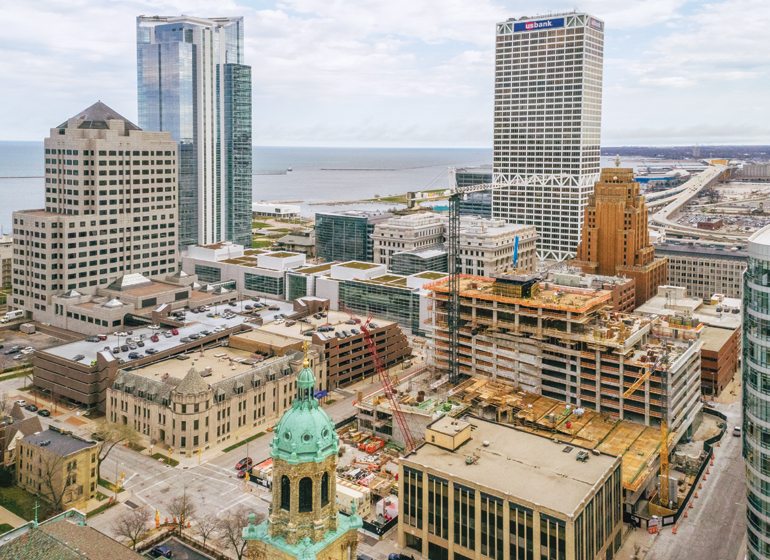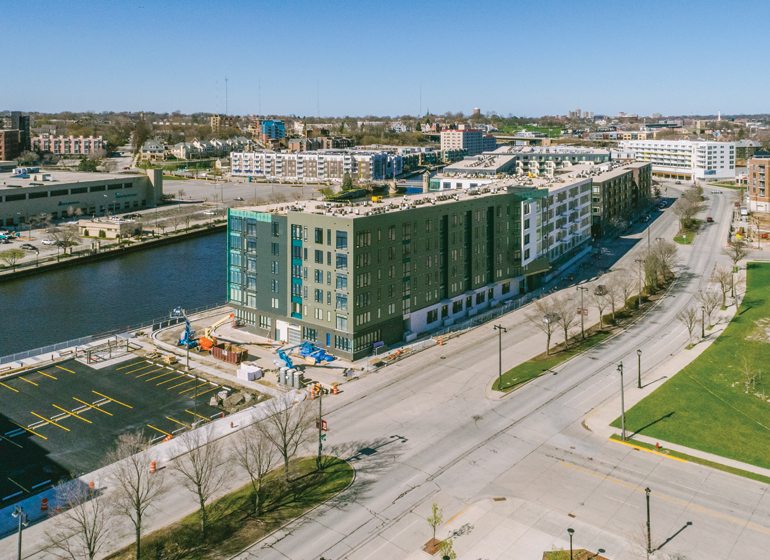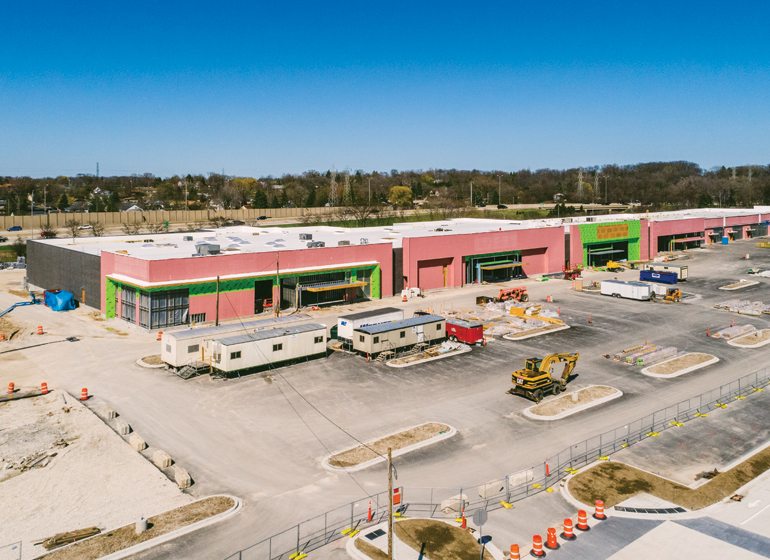Southeastern Wisconsin has sustained a construction boom for the past five years, particularly with multifamily housing developments being built in and near downtown Milwaukee.
And while there are signs the market may be maturing as some developers and banks are putting the brakes on future projects, development and construction industry experts are confident the industry has not hit its peak as other areas, including senior living and industrial, continue to grow.

“We are still seeing growth, but it is a more strategic, thought-out process,” said Ben Goetter, general manager and director of projects for M.A. Mortenson Co.’s Brookfield office. “No one is jumping into the ground with a shovel. Now it is (based on) what makes sense to the market and to corporate budgets.”
Over the past 18 months, the diversity of Minneapolis-based Mortenson’s portfolio has broadened, Goetter said. The company, which was selected last year to manage the construction of the new $524 million Milwaukee Bucks arena, continues to have a robust health care and corporate business, but also has expanded its senior living and industrial business.
Mortenson currently is working on a 192,000-square-foot expansion project at the St. Camillus campus in Wauwatosa that will add 72 units and a Jesuit residential facility with 48 units to the senior and long-term care complex.
Over the past two years, Mortenson also has completed a conference center and a 1.1 million-square-foot distribution center for Uline in Pleasant Prairie.

“I think the key is to stay nimble,” Goetter said. “Apartment construction has slowed down, but I think there is still plenty of opportunity to bring housing downtown. Right now, we are seeing an upswing in senior and industrial projects, but the energy is downtown, and people want to live by that energy.”
The local construction boom took off in 2013, when Northwestern Mutual Life Insurance Co. announced it would construct a $450 million, 32-story tower at its headquarters campus in downtown Milwaukee, triggering confidence in both the city’s development and business communities.
What has followed has been an unprecedented number of building projects either underway or planned in downtown Milwaukee and much of southeastern Wisconsin.
Those projects include the Bucks arena, which is leading to the complete development of the Park East Corridor; a downtown streetcar; the Couture, a 44-story apartment tower that will break ground in December; The Corners of Brookfield, an outdoor shopping mall and mixed-use development; and other mixed-use and “urban lifestyle” developments in the suburbs.
Rethinking the apartment market
The same year Northwestern Mutual began construction on its downtown Milwaukee headquarters, developers began building apartments, filling a void left in the market by the 2002 to 2008 condominium boom, followed by five years of no multifamily building, said Robert Monnat, a partner at Mandel Group Inc., one of the city’s most prominent apartment builders.
One of the staples of this apartment boom has been high-end apartments in downtown Milwaukee targeted at millennials.

In just five years, the stretch from South Kinnickinnic Avenue in Bay View to North Water Street in downtown Milwaukee has gone from barren to booming, with five- and six-story apartment buildings lining the street. Inside, the complexes could be described as expensive adult dorm rooms. Only instead of shared bathrooms, millennials are sharing rooftop terraces, pet spas and theater rooms.
Of course, granite countertops, stainless steel appliances and balconies overlooking the Milwaukee River come at a price – especially as construction costs continue to rise for developers. Since 2012, construction costs, which comprise about 70 percent of the cost of a development, have increased 40 percent, according to Monnat.
The cost of raw materials has increased, on a year-to-year basis, between 5.5 percent for cement and 35 percent for diesel fuel, according to recent data from the Bureau of Labor Statistics compiled by The Concord Group, a Chicago-based construction consulting firm.
“We’ve gotten smoked in terms of our ability to afford the construction costs we’re being asked to pay,” Monnat said.
Higher construction costs, compounded with creeping interest rates and commercial banks becoming more selective and enforcing stricter guidelines for multifamily real estate loans following concerns about overbuilding, have made it necessary for developers to charge high rents.
A one-bedroom apartment at Mandel’s The North End development on North Water Street ranges from about $1,100 to $1,600 a month.
Across the street at The Rhythm, one of Milwaukee’s newer apartment buildings developed by New Land Enterprises, rents start at $1,315 for a 405-square-foot studio and go up to $1,795 for a one-bedroom apartment. Gokhman built most of Rhythm’s 140 apartments as micro-sized units to keep the costs down.
About three years ago, Mandel Group concluded that these types of rents could not be sustained by millennials and decided to shift its focus to baby boomers who no longer want the hassle of homeownership.

“For a millennial, the difference between a $1,000 rent and a $1,500 rent is meaningful,” said Ian Martin, vice president of development at Mandel Group. “Rent elasticity in the baby boomer market is different. When you are downsizing out of a 3,000-square-foot house in Fox Point or Whitefish Bay, the difference between a $2,000 to $2,500 a month rent is not as meaningful.”
Mandel’s Beaumont Place, an 88-unit luxury apartment complex in Whitefish Bay, was 100 percent leased by baby boomers before it was built. Rents range from $1,522 to $3,148.
According to Monnat, demand has never been higher for apartments, but high-end apartments for millennials have been overbuilt.
“The market is beginning to exhibit normal characteristics where you have to think about what you are doing again,” Monnat said. “It used to be biking downhill. At some point, you hit the bottom and you have to start pedaling again to get where you are going, and that is where we are.”
The demand for senior housing
Baby boomers are now between 50 and 70 years old, and everything from luxury-style apartments targeted toward empty nesters to memory care units are being built for them in the city and suburbs.
Waukesha-based Capri Communities LLC, which owns and operates 11 senior living facilities in southeastern Wisconsin, purchased a campus in Port Washington in January and announced it would spend $20 million to expand the independent living and memory care space at the facility.
The following month, Capri announced it would invest $21 million in its Gables of Germantown facility with additional independent living, assisted living and memory care residences across from its existing campus.
Senior living facilities offering the full spectrum of independent care to memory care are planned across the suburbs and the city.
Saint John’s on The Lake on Milwaukee’s East Side is planning a third tower on the corner of North Prospect Avenue and East Kane Place that will serve the 74 residents living in the skilled nursing assisted living portion of the community.
Senior living projects also are planned in Franklin, Sussex, Brown Deer, Brookfield, Glendale and Muskego.
Even Drexel Town Square, the mixed-use development in Oak Creek that boasts restaurants, retail and high-end apartments, has carved out a space for seniors. Minnesota-based senior living apartment developer The Waters Senior Living LLC purchased 2.5 acres in the development to build a senior living facility there with up to 140 apartments.
Brian Schack, associate developer for The Waters, said the company, which has developed and operates seven senior communities in the Twin Cities metropolitan area and Rochester, Minnesota, had been looking at the Milwaukee area for more than a year and is considering other locations in the area.
Evolving economy
The industrial real estate market continues to grow in southeastern Wisconsin. More than 2.2 million square feet of industrial space currently is under construction in the area, according to the latest data released by the Commercial Association of Realtors Wisconsin and Xceligent.
In recent years, 350,000 square feet of retail space in the Milwaukee area has been repurposed for other uses. Many of those uses have been industrial space.
Fox Point-based real estate firm General Capital Group LLC has taken two vacant retail properties on the north side of Milwaukee off the market recently. The company is planning to redevelop a 118,461-square-foot former Target store on West Brown Deer Road in Milwaukee and market it to potential industrial tenants.

General Capital Group also purchased the 138,480-square-foot former Sam’s Club at 7701 W. Calumet Road to convert it to industrial space and lease it to Sellars Absorbent Materials Inc., a local paper towel and wet wipe distributor.
Mark Henschel, vice president of commercial lending at Milwaukee-based Park Bank, said since Jan. 1, he has seen a broader scope of commercial real estate loan requests, including more applications for senior housing developments and warehouse acquisitions or industrial developments.
Park Bank still is adding multifamily loans to its portfolio, but Henschel said the applications have slowed down. Multifamily developers are having a more difficult time securing loans.
In 2015, new regulations went into effect forcing multifamily borrowers to contribute at least 15 percent of the real estate’s appraised as completed value prior to the advancement of funds by the bank. This has driven up the cost for developers.
“I think a lot of banks are on pause for a bit to monitor absorption and see how the rents line up,” Henschel said. “There is also a crossover between apartment development and senior housing, where people are beginning to blur the lines between creating developments for empty nesters and an independent living facility.”
Mandel Group’s plan to develop 105 high-end apartments in Fox Point at the former Dunwood Elementary School site also includes an 80-bed assisted living facility.
“Projects are going to continue to get built, but they are going to get built only if there is true demand,” Monnat said. “We’re acclimating back to normal now and as we do, it’s going to be very challenging to get projects done.”
Construction labor shortage
In addition to higher construction costs and tighter banking regulations, finding skilled labor also has been a struggle for contractors, particularly with so many large projects currently underway.
According to the Associated General Contractors of America, construction employment is at its highest level since 2008, with 6.8 million people working in the field. At the same time, skilled labor availability continues to put pressure on construction costs as a whole.

John Hunzinger, president of Brookfield-based Hunzinger Construction Co., said the Milwaukee market is luckier than most because it was able to retain many very good specialty contracting companies through the Great Recession.
Still, the cost of labor continues to steadily increase, contributing to the rising costs of construction projects, Hunzinger said.
“When you start to compare building costs today to what they were during the recession, you see some impressive gains,” Hunzinger said. “I think there was a pent-up demand. Labor contracts that had multi-year agreements have been negotiated and supply and demand are driving up material prices. That is all moving in lockstep.”
According to The Concord Group, construction costs will continue to rise 3 to 4 percent in 2017 and all major contractors and subcontractors are reporting a significant amount of work booked through the year, which suggests demand is continuing to rise.
As far as Milwaukee’s construction “boom” continuing, Hunzinger said it depends when you ask the question. The market ebbs and flows, he said.
“We’re seeing growth opportunities in every sector,” Hunzinger said. “Some are just more dynamic than others. Multi-family is still hot, even if some projects have pulled back a bit. I think we’ll still see other projects announced. I don’t pretend to know about absorption rates, but there doesn’t seem to be a lack of interest.”
Rick Schmidt, president and chief executive officer of Milwaukee-based C.G. Schmidt Inc., agreed that the workload is still very strong.
“Over the next couple of years, I believe it will continue to be strong and the opportunities will still be there,” Schmidt said.
School building projects also will keep contractors busy. On April 4, Wisconsin voters approved $700 million in school referendums for new building projects in numerous districts all over the state, including Grafton, Verona and Green Bay.
Schmidt believes his company will continue to see growth in its corporate industrial, senior living and education business in the coming years.
Still, that growth likely will be less than in previous years. C.G. Schmidt experienced a 25 percent revenue increase from 2015 to 2016. Schmidt is anticipating a 15 percent jump this year over 2016.
“To me, it doesn’t feel like we are nearing the end of the boom. Next year and the year after, we have a very solid pipeline of construction projects in the markets where we operate,” Schmidt said. “They may not be really huge, sexy projects coming up, but there is a lot of work.”


